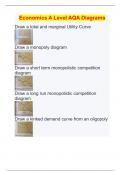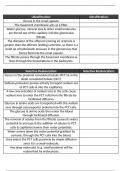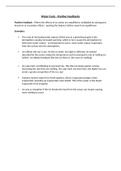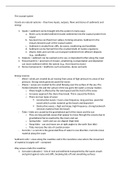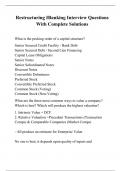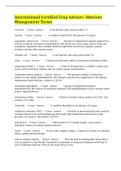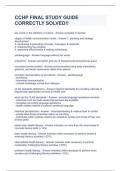Module 2 A level biology OCR
Cell structure
• Microscopes:
o use of microscopy to observe and investigate different types of cell and cell structures in a range of
eukaryotic organisms
o Light microscopes:
§ Light microscopes have a resolution of 50 - 200 nm and a magnification of x1500
§ The resolution of light microscopes is not high enough to see mitochondria with as the
wavelength of light is too long
§ they are used to see cells and large organelles like mitochondria and the nucleus
o Scanning electron microscopes:
§ have a magnification of 50,000-500,000x
§ a resolution of 0.4-20 nm,
§ are used for viewing the surface of cells and organelles, and providing depth in three-
dimensional images.
§ the specimen has to be dead
o Transmission electron microscopes:
§ have a magnification of 300,000-1,000,000x,
§ a resolution of 0.05-1.0 nm
§ are used for detailing organelle ultrastructure.
§ The sample must be dried out and is therefore dead. This may affect the shape of the
features seen (called an artefact).
§ the image is in black and white, but colours may be added later by computer graphics. These
are called false colour electron micrographs.
o Laser scanning confocal:
§ Laser scanning confocal microscopes have a magnification of 1000-2000x,
§ a resolution of 50-200 nm
§ are used to produce three-dimensional images with good depth selection.
§ see living things and have the advantage that they can focus at a specific depth so the
image is not confused by other components that are not in focus.
§ It relies on a computer to piece together all the information from the dots of light created
by the lasers. This means that the image is an interpretation rather than a real-life image.
o Staining:
§ use of differential staining to identify different cellular components and cell types.
§ makes objects visible in light microscope
§ Increases contrast so that the object can be seen more clearly
§ examples of stains:
§ acetic orcein stains chromosomes dark red
§ eosin stains cytoplasm
§ Sudan red stains lipids
§ iodine in potassium iodide solution stains the cellulose in plant cell walls yellow and
starch granules blue/black
o Magnification and Resolution:
§ magnification is the ratio of image size to object size (size of image/size of the object)
§ Resolution is the ability to distinguish between two objects that are close together
§ to calculate the magnification use the formula: Mag = image size/ object size
• Cell ultrastructure
, • Cellular components of a eukaryotic cell:
o Flagella - large extension of cell surface membrane containing microtubules. they are able to beat to
enable locomotion or move fluids
o Golgi apparatus - modifies proteins made in the ribosomes. often adds a carbohydrate group.
repackages proteins into vesicles for secretion
o Lysosomes - small vacuoles containing hydrolytic or lytic enzymes
o Mitochondria - site of aerobic respiration
o Nucleus - contains the genetic material (chromosomes) and controls the cell activity
o Nuclear envelope - separates the genetic material from the cytoplasm. the nuclear pores allow
molecules of mRNA to pass from teg nucleus to the ribosomes in the cytoplasm
o Nucleolus - assembles the ribosomes
o Ribosomes - site of protein synthesis
o Rough endoplasmic reticulum - holds many of the ribosomes. provides a large surface area for protein
synthesis
o Smooth endoplasmic reticulum - Associated with the synthesis, storage and transportation of lipids
and carbohydrates
o Centrioles - involved in the organisation of microtubules that make up the cytoskeleton. Form the
spindle fibres used to move chromosomes in nuclear division
o Cilia - small hair-like extension of cell-surface membrane containing microtubules. large number works
in a synchronised fashion. Able to move whole organism or to move fluid (mucus) across a surface
o Cytoskeleton - a network of microtubules and microfilaments. It provides mechanical strength,
support and structure for the cell. It also maintains the cell shape and is used in some cells to change
the cell's shape. Enables movement of organelles inside the cell and Enables movement of the whole cell
o Additional components in plant cells and not in animals’
§ cell wall - cellulose cell wall surrounds plant cells
§ chloroplasts - site of photosynthesis
o Organelles involved in the production and secretion of proteins
§ mRNA leaves the nucleus via the nuclear pores
§ It is used by the ribosomes on the rough endoplasmic reticulum to construct a protein
§ The protein travels in a vesicle to the Golgi apparatus
§ The vesicle is moved by the cytoskeleton possibly using tiny protein motors that walk along
the microtubules using them as a track
§ The Golgi apparatus modifies the protein often adding a carbohydrate group and
repackaging it into a vesicle
§ This vesicle is moved to the cell surface membrane the vesicle fuses with the membrane to
release the protein from the cell
• Similarities and differences between prokaryotes and eukaryotes:
Prokaryotes Eukaryotes
smaller - about 10 um long and 1-2 um wide larger - about larger than 10 um in diameter
No nucleus Have a nucleus
they have no membrane-bound organelles they have membrane-bound organelles
They have 70 s ribosomes they have 80s ribosomes
contain a single loop of DNA and no histones DNA strand not loop - associated with histones
some of them have flagella however it has a very have flagella
different structure
, Biological Molecules
• Water
o hydrogen bonding occurs between water molecules
• there is an attraction between the oxygen of one water molecule and the hydrogen of another
molecule
• occurs as water is polar meaning there is an uneven distribution of charge.
o Properties of water that relate to hydrogen bonding:
§ Thermal stability — water has a high specific heat capacity which means that a lot of
energy is needed to warm it up. This because a lot of energy is required to overcome the
force of its hydrogen bonds between the molecules. Therefore, a body of water maintains a
fairly constant temperature, which is essential for life to survive.
§ Causes cohesion - it moves as one mass because the molecules are attracted to each other.
this is why plants are able to draw water up their roots and how we are able to drink water
through a straw
§ Ice - less dense than water. hydrogen bonds fic the positions of the polar molecules slightly
further apart than the average distance in the liuid state. this produces a giant, rigid but
open structure. it also provides an insulating layer above in water bodies as aquatic animals
would not be able to survive in freezing temperatures
§ Solvent - many solutes in an organism can be dissolved as its a polar molecule
§ medium - acts as a medium for chemical reactions and also helps transport dissolved
compounds into and out of cells
§ Coolant - helping to buffer temperature changes during chemical reactions.
§ Surface tension - due to hydrogen bonding. strong enough to support small insects for
example pond skaters.
• Monomers and Polymers:
o Many molecules are polymers. These molecules are long chains that comprise a number of similar
smaller molecules known as monomers.
o Biological molecules - carbohydrates, lipids, proteins and nucleic acids
o chemical elements that make up biological molecules are:
§ C, H and O for carbohydrates
§ C, H and O for lipids
§ C, H, O, N and S for proteins
§ C, H, O, N and P for nucleic acids
o Condensation and hydrolysis reactions
§ monomers are joined together by covalent bonds via condensation reactions
§ condensation reaction - when two molecules join to become one larger molecule via the
formation of a covalent bond and the release of a water molecule.
§ Hydrolysis reaction - the bond can be broken again via hydrolysis. Hydrolysis is when
molecules that were covalently bonded together are split apart using a molecule of water.
• Carbohydrates
o Divided into 3 main group : Monosaccharides, Disaccharides and Polysaccharides.
§ Monosaccharides - They are the single sugar units that are used as monomers to build other
carbohydrates. they are soluble and reducing sugars. Glucose is an example.
Cell structure
• Microscopes:
o use of microscopy to observe and investigate different types of cell and cell structures in a range of
eukaryotic organisms
o Light microscopes:
§ Light microscopes have a resolution of 50 - 200 nm and a magnification of x1500
§ The resolution of light microscopes is not high enough to see mitochondria with as the
wavelength of light is too long
§ they are used to see cells and large organelles like mitochondria and the nucleus
o Scanning electron microscopes:
§ have a magnification of 50,000-500,000x
§ a resolution of 0.4-20 nm,
§ are used for viewing the surface of cells and organelles, and providing depth in three-
dimensional images.
§ the specimen has to be dead
o Transmission electron microscopes:
§ have a magnification of 300,000-1,000,000x,
§ a resolution of 0.05-1.0 nm
§ are used for detailing organelle ultrastructure.
§ The sample must be dried out and is therefore dead. This may affect the shape of the
features seen (called an artefact).
§ the image is in black and white, but colours may be added later by computer graphics. These
are called false colour electron micrographs.
o Laser scanning confocal:
§ Laser scanning confocal microscopes have a magnification of 1000-2000x,
§ a resolution of 50-200 nm
§ are used to produce three-dimensional images with good depth selection.
§ see living things and have the advantage that they can focus at a specific depth so the
image is not confused by other components that are not in focus.
§ It relies on a computer to piece together all the information from the dots of light created
by the lasers. This means that the image is an interpretation rather than a real-life image.
o Staining:
§ use of differential staining to identify different cellular components and cell types.
§ makes objects visible in light microscope
§ Increases contrast so that the object can be seen more clearly
§ examples of stains:
§ acetic orcein stains chromosomes dark red
§ eosin stains cytoplasm
§ Sudan red stains lipids
§ iodine in potassium iodide solution stains the cellulose in plant cell walls yellow and
starch granules blue/black
o Magnification and Resolution:
§ magnification is the ratio of image size to object size (size of image/size of the object)
§ Resolution is the ability to distinguish between two objects that are close together
§ to calculate the magnification use the formula: Mag = image size/ object size
• Cell ultrastructure
, • Cellular components of a eukaryotic cell:
o Flagella - large extension of cell surface membrane containing microtubules. they are able to beat to
enable locomotion or move fluids
o Golgi apparatus - modifies proteins made in the ribosomes. often adds a carbohydrate group.
repackages proteins into vesicles for secretion
o Lysosomes - small vacuoles containing hydrolytic or lytic enzymes
o Mitochondria - site of aerobic respiration
o Nucleus - contains the genetic material (chromosomes) and controls the cell activity
o Nuclear envelope - separates the genetic material from the cytoplasm. the nuclear pores allow
molecules of mRNA to pass from teg nucleus to the ribosomes in the cytoplasm
o Nucleolus - assembles the ribosomes
o Ribosomes - site of protein synthesis
o Rough endoplasmic reticulum - holds many of the ribosomes. provides a large surface area for protein
synthesis
o Smooth endoplasmic reticulum - Associated with the synthesis, storage and transportation of lipids
and carbohydrates
o Centrioles - involved in the organisation of microtubules that make up the cytoskeleton. Form the
spindle fibres used to move chromosomes in nuclear division
o Cilia - small hair-like extension of cell-surface membrane containing microtubules. large number works
in a synchronised fashion. Able to move whole organism or to move fluid (mucus) across a surface
o Cytoskeleton - a network of microtubules and microfilaments. It provides mechanical strength,
support and structure for the cell. It also maintains the cell shape and is used in some cells to change
the cell's shape. Enables movement of organelles inside the cell and Enables movement of the whole cell
o Additional components in plant cells and not in animals’
§ cell wall - cellulose cell wall surrounds plant cells
§ chloroplasts - site of photosynthesis
o Organelles involved in the production and secretion of proteins
§ mRNA leaves the nucleus via the nuclear pores
§ It is used by the ribosomes on the rough endoplasmic reticulum to construct a protein
§ The protein travels in a vesicle to the Golgi apparatus
§ The vesicle is moved by the cytoskeleton possibly using tiny protein motors that walk along
the microtubules using them as a track
§ The Golgi apparatus modifies the protein often adding a carbohydrate group and
repackaging it into a vesicle
§ This vesicle is moved to the cell surface membrane the vesicle fuses with the membrane to
release the protein from the cell
• Similarities and differences between prokaryotes and eukaryotes:
Prokaryotes Eukaryotes
smaller - about 10 um long and 1-2 um wide larger - about larger than 10 um in diameter
No nucleus Have a nucleus
they have no membrane-bound organelles they have membrane-bound organelles
They have 70 s ribosomes they have 80s ribosomes
contain a single loop of DNA and no histones DNA strand not loop - associated with histones
some of them have flagella however it has a very have flagella
different structure
, Biological Molecules
• Water
o hydrogen bonding occurs between water molecules
• there is an attraction between the oxygen of one water molecule and the hydrogen of another
molecule
• occurs as water is polar meaning there is an uneven distribution of charge.
o Properties of water that relate to hydrogen bonding:
§ Thermal stability — water has a high specific heat capacity which means that a lot of
energy is needed to warm it up. This because a lot of energy is required to overcome the
force of its hydrogen bonds between the molecules. Therefore, a body of water maintains a
fairly constant temperature, which is essential for life to survive.
§ Causes cohesion - it moves as one mass because the molecules are attracted to each other.
this is why plants are able to draw water up their roots and how we are able to drink water
through a straw
§ Ice - less dense than water. hydrogen bonds fic the positions of the polar molecules slightly
further apart than the average distance in the liuid state. this produces a giant, rigid but
open structure. it also provides an insulating layer above in water bodies as aquatic animals
would not be able to survive in freezing temperatures
§ Solvent - many solutes in an organism can be dissolved as its a polar molecule
§ medium - acts as a medium for chemical reactions and also helps transport dissolved
compounds into and out of cells
§ Coolant - helping to buffer temperature changes during chemical reactions.
§ Surface tension - due to hydrogen bonding. strong enough to support small insects for
example pond skaters.
• Monomers and Polymers:
o Many molecules are polymers. These molecules are long chains that comprise a number of similar
smaller molecules known as monomers.
o Biological molecules - carbohydrates, lipids, proteins and nucleic acids
o chemical elements that make up biological molecules are:
§ C, H and O for carbohydrates
§ C, H and O for lipids
§ C, H, O, N and S for proteins
§ C, H, O, N and P for nucleic acids
o Condensation and hydrolysis reactions
§ monomers are joined together by covalent bonds via condensation reactions
§ condensation reaction - when two molecules join to become one larger molecule via the
formation of a covalent bond and the release of a water molecule.
§ Hydrolysis reaction - the bond can be broken again via hydrolysis. Hydrolysis is when
molecules that were covalently bonded together are split apart using a molecule of water.
• Carbohydrates
o Divided into 3 main group : Monosaccharides, Disaccharides and Polysaccharides.
§ Monosaccharides - They are the single sugar units that are used as monomers to build other
carbohydrates. they are soluble and reducing sugars. Glucose is an example.

